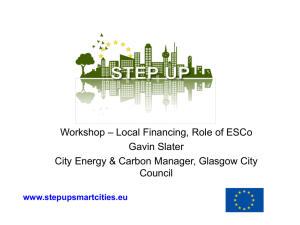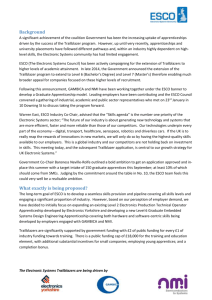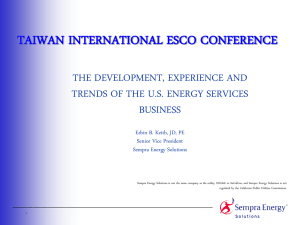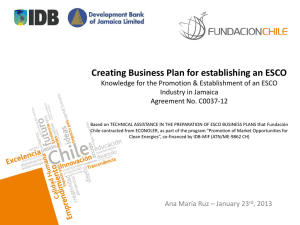PART 3. Evaluation Process
advertisement
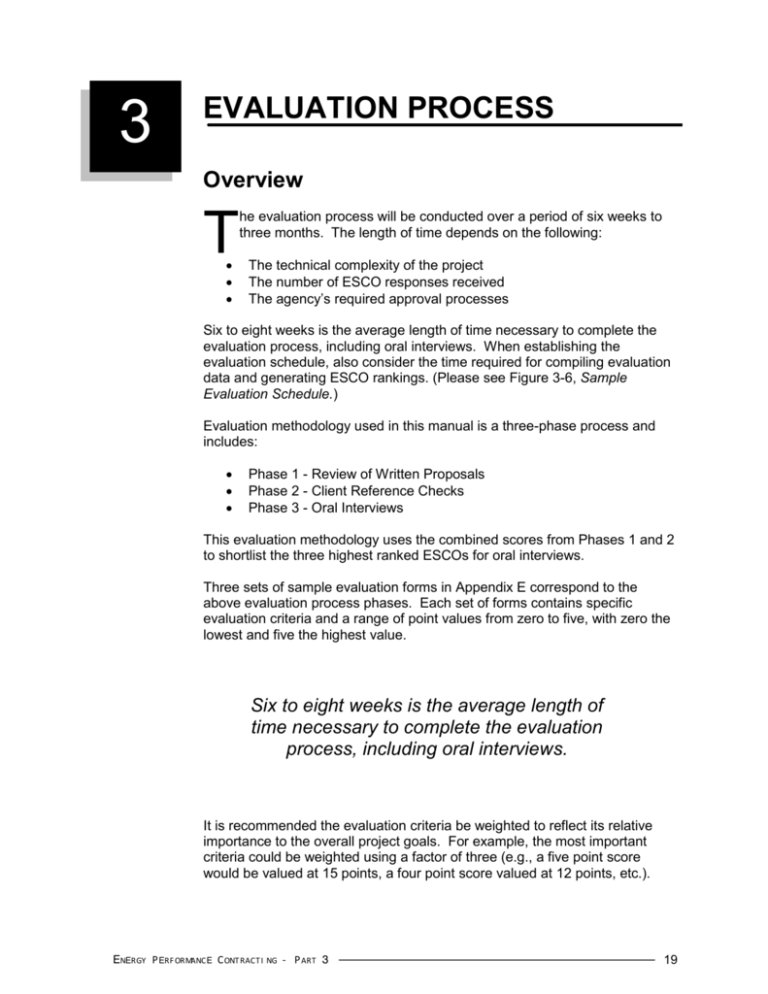
THE 3 EVALUATION PROCESS Overview T he evaluation process will be conducted over a period of six weeks to three months. The length of time depends on the following: The technical complexity of the project The number of ESCO responses received The agency’s required approval processes Six to eight weeks is the average length of time necessary to complete the evaluation process, including oral interviews. When establishing the evaluation schedule, also consider the time required for compiling evaluation data and generating ESCO rankings. (Please see Figure 3-6, Sample Evaluation Schedule.) Evaluation methodology used in this manual is a three-phase process and includes: Phase 1 - Review of Written Proposals Phase 2 - Client Reference Checks Phase 3 - Oral Interviews This evaluation methodology uses the combined scores from Phases 1 and 2 to shortlist the three highest ranked ESCOs for oral interviews. Three sets of sample evaluation forms in Appendix E correspond to the above evaluation process phases. Each set of forms contains specific evaluation criteria and a range of point values from zero to five, with zero the lowest and five the highest value. Six to eight weeks is the average length of time necessary to complete the evaluation process, including oral interviews. It is recommended the evaluation criteria be weighted to reflect its relative importance to the overall project goals. For example, the most important criteria could be weighted using a factor of three (e.g., a five point score would be valued at 15 points, a four point score valued at 12 points, etc.). ENERGY P ERF ORMANCE C ONT RACT I NG - P ART 3 19 Less important criteria would be weighted by a factor of two (e.g., a five point score would be valued at 10). For all three phases of the evaluation process, the evaluation criteria has been aggregated and organized into the following four categories: Past Experience Project Management Approach Technical Capabilities & Expertise Financial Strength These categories are useful for comparing the rankings of ESCOs in each category and in the presentation of evaluation data. One important design feature of the evaluation methodology is the “Unable to Rank” category. The evaluator always should choose this category when they have insufficient personal knowledge or experience to fairly rank a specific criterion. Checking "Unable to Rank" has no point value and therefore no impact (negative or positive) on the ESCO’s overall score. This has been included to avoid unfairly penalizing or rewarding an ESCO for the evaluator’s lack of expertise. On the other hand, a "Not Acceptable" ranking should be given when information requested to be provided by the ESCO is insufficient, nonresponsive, or of poor quality. A "Not Acceptable" ranking does have a negative impact on point scoring. It is extremely important to instruct the evaluation team members on the difference between the "Not Acceptable" and "Unable to Rank" categories. The distinction between these two categories must be emphasized, then consistently used in all phases of the evaluation process. Figures 3-1 through 3-5 are sample bar charts which graphically illustrate how the cumulative scores from each phase of the evaluation could be presented and the rankings visually compared. 20 ENERGY PERFORMANCE CONTRACTING - PART 3 Evaluation Procedures Phase 1: Written Proposals Review of the written proposals submitted by competing ESCOs, is the first phase of the evaluation. The written proposals provide the basic information for review and investigation throughout the selection process. It is recommended that all proposals be read before the evaluation team members begin their rankings. This initial reading familiarizes the evaluators with the proposal content, how the information is presented and organized, and gives the evaluators a sense of qualification variations between competing ESCOs. It is important to note that this a comparative evaluation methodology. Team members will be ranking the competing field of ESCOs to each other, not to an abstract standard or ideal. A simple way to conduct these evaluations is with a side-by-side comparison of the written proposals. To assist evaluators in their comparative review, each criterion on the Sample Written Evaluation Form located in Appendix E, which may be indexed to identify where the relevant proposal information is located. Figure 3-1 is a sample bar chart that illustrates evaluation rankings from Phase 1 - Written Proposals from a field of six competing ESCOs. FIGURE 3-1 Energy Performance Contracting Program Sample Comparative Evaluation Rankings Phase 1: Written Proposals Experience Management Technical Financial 350 300 POINT TOTALS 250 200 150 100 50 0 ESCO 1 ESCO 2 ESCO 3 ESCO 4 ESCO 5 ESCO 6 Energy Service Companies ENERGY P ERF ORMANCE C ONT RACT I NG - P ART 3 21 Phase 2: Client References The evaluation of client references provided by the ESCO can be conducted concurrently with the evaluation of written proposals. At least three telephone reference checks are recommended. Each call typically takes 10 to 15 minutes. Every reference should be asked the same set of prepared interview questions listed on the Sample Client Reference Evaluation Form located in Appendix E. It is important to request that the responding reference rank the ESCO in accordance with the point values indicated on the form. This approach alleviates an evaluator's subjective interpretation of the reference's response. Since each ESCO will provide a number of client references, the task of checking references can be distributed among the evaluation team members. This phase of the evaluation process is critical to the review of ESCO proposals since client references provide specific information about the ESCOs past performance and their overall satisfaction with the project. Figure 3-2 illustrates the Phase 2 - Client References evaluation rankings from a field of six competing ESCOs. FIGURE 3-2 Energy Performance Contracting Program Sample Comparative Evaluation Rankings Phase 2: Client References Experience Management Technical Financial 250 POINT TOTALS 200 150 100 50 0 ESCO 1 ESCO 2 ESCO 3 ESCO 4 ESCO 5 ESCO 6 Energy Service Companies 22 ENERGY PERFORMANCE CONTRACTING - PART 3 ESCO Shortlist Once the tabulated results of Phases 1 and 2 are combined, the cumulative scores will be used to shortlist the three highest ranking firms. These firms then will be invited to participate in oral interviews. A Sample Invitation Letter for Oral Interviews is located in Appendix F. Figure 3-3 represents cumulative scores from Phases 1 and 2 for each of the six competing ESCOs. Based on these rankings, ESCOs 2, 4, and 5 will be shortlisted for participation in Phase 3 - Oral Interviews. FIGURE 3-3 Energy Performance Contracting Program Summary of Phases 1 & 2 Sample Evaluation Rankings Written Submissions & Client References Experience Management Technical Financial 600 500 POINT TOTALS 400 300 200 100 0 ESCO 1 ESCO 2 ESCO 3 ESCO 4 ESCO 5 ESCO 6 Energy Service Companies ENERGY P ERF ORMANCE C ONT RACT I NG - P ART 3 23 Phase 3: Oral Interviews Each oral interview can range from one and one half-hours to three hours in length. The interviews should be structured with a 30-minute time limit for ESCO formal presentations. The ESCOs should be told in advance of the presentation time schedule. Reserve the remaining time for direct questions by the evaluation team. It is recommended that two sets of questions be prepared in advance of the interviews. One question set should be asked of all ESCOs on a variety of topics. The second set of questions should be based on the specific information contained in each ESCOs proposal or on other information gathered from client references. One team member should be designated as the question facilitator. However, the format should be open enough so that all members of the evaluation team have the opportunity to ask questions as they arise. It is suggested that each ESCO be ranked immediately following their oral interview. At the conclusion of all oral interviews, evaluators may re-rank the companies and discuss their impressions with other team members. A Sample Oral Interview Evaluation Form is located in Appendix E. Figure 3-4 illustrates the evaluation results of Phase 3 - Oral Interviews from the three shortlisted ESCOs. FIGURE 3-4 Energy Performance Contracting Program Sample Comparative Evaluation Rankings Phase 3: Oral Interviews 250 Experience Management Technical Financial POINT TOTALS 200 150 100 50 0 ESCO 2 ESCO 4 ESCO 5 Energy Service Companies 24 ENERGY PERFORMANCE CONTRACTING - PART 3 ESCO Selection Ranking data collected from Phase 3 should be tabulated and added to the cumulative scores from Phases 1 and 2. This results in the final evaluation ranking for each ESCO. At this point, a final team meeting should be held to gain consensus for final ESCO selection. Figure 3-5 illustrates final rankings from Phases 1, 2, and 3 of the evaluation process. FIGURE 3-5 Energy Performance Contracting Program Sample Evaluation Process Overview Phases 1, 2 & 3: Written Submissions, Client References & Oral Interviews Experience Management Technical Financial 800 700 POINT TOTALS 600 500 400 300 200 100 0 ESCO 2 ESCO 4 ESCO 5 Energy Service Companies ENERGY P ERF ORMANCE C ONT RACT I NG - P ART 3 25 FIGURE 3-6 The following tips have been compiled to assist agencies in conducting a successful evaluation of ESCOs who respond to the RFP. Assemble a diverse evaluation team who will bring a broadbase of technical, financial, and legal expertise to the process Weigh each criterion in accordance with its importance to the project (e.g., a weighted value of three for most important and a weighted value of two for less important items that are negotiable) Briefly review all written proposals before ranking any proposals Conduct a side-by-side comparison of written proposals Check the “Unable to Rank” category if there is any uneasiness in evaluating any of the criteria Check the “Unacceptable” category if the ESCO does not provide sufficient information or the information is of poor quality Conduct a minimum of three client reference checks for each ESCO Ask client references to indicate a specific ranking in response to each criterion Shortlist the three highest ranking firms for participation in oral interviews Prepare two (2) sets of interview questions in advance of the oral interviews (general and proposal-specific) Designate one evaluation team member to facilitate questioning Limit formal ESCO presentations at the oral interviews to 30 minutes Gain consensus of the evaluation team in the final ESCO selection 26 ENERGY PERFORMANCE CONTRACTING - PART 3 FIGURE 3-7 SAMPLE EVALUATION SCHEDULE (8 WEEKS) Activity Timeframe Receive Written Responses to RFP ..................................................................... Week 1 Evaluate Written Responses (Phase 1) .......................................................... Weeks 2-4 Conduct Client Reference Checks (Phase 2) .................................................. Weeks 2-4 Tabulate Phases 1 and 2 Rankings ..................................................................... Week 5 Shortlist to the Three Highest Ranked ESCOs ............................................... Weeks 5-6 Invite Shortlisted ESCOs to Oral Interviews .................................................... Weeks 5-6 Conduct and Evaluate Oral Interviews (Phase 3) ............................................ Weeks 6-7 Tabulate Phase 3 Rankings and Add to Rankings from Phases 1 and 2 ........ Weeks 7-8 Select Highest Ranked ESCO to Proceed with Project ........................................ Week 8 ENERGY P ERF ORMANCE C ONT RACT I NG - P ART 3 27 28 ENERGY PERFORMANCE CONTRACTING - PART 3
